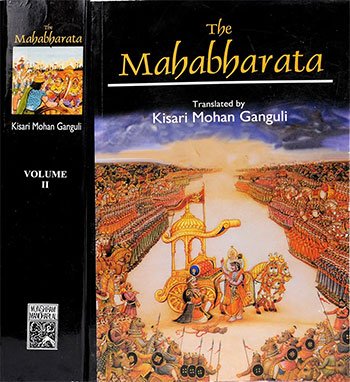Section LI - The Story of Death and Destruction in Hindu Mythology
Book index: Mahabharata (English)
This page contains a summary of the Mahabharata Section LI including examples of moral lessons in daily life. The Maha-Bharata is one of the largest epics ever written containing roughly 100,000 Sanskrit verses. It deals with the legendary history of ancient India and contains a large number of interwoven tales.
Short summary of the chapter:
Brahma had created a diverse range of creatures but was filled with compassion as he saw them being consumed by fire. Rudra urged Brahma to calm his wrath and prevent further destruction of the universe. Brahma, in desire of benefiting creatures, held back his wrath and extinguished the fire. A female figure, Death, emerged from Brahma's body and was commanded to slay all creatures by Brahma. Death, feeling helpless, wept as Brahma implored her to fulfill his command for the benefit of all creatures.
Full English translation:
This page is merely a summary which is automatically generated. If you are looking for authentic sources such as the Sanskrit text or the Full English translation of Mahabharata Section LI - The Story of Death and Destruction in Hindu Mythology, have a look at the following articles:
Section LI, online text
English translation by Kisari Mohan Ganguli.
Read this and other chapters online.
Mahabharata (English Summary)
by Kisari Mohan Ganguli | ISBN-10: 8121505933
Buy the latest edition:
FAQ of Mahabharata, Section LI:
What was the reason for Brahma's wrath and how did it affect the universe?
Brahma's wrath was due to the Earth urging him to destroy creatures. This led to the creation of a destructive fire that began consuming the universe.
How did Rudra and Brahma try to appease the destructive fire and protect the creatures?
Rudra urged the divine Being to show grace and not let the universe be destroyed. Brahma held back his wrath and declared the duties of Production and Emancipation while addressing Death to slay creatures for the greater good.
Daily life: The Story of Death and Destruction in Hindu Mythology:
The story illustrates a powerful lesson about responsibility, compassion, and the consequences of anger. It teaches us that in our roles, whether as leaders, protectors, or creators, we carry the burden of making decisions that affect the well-being of others. Just like Brahma and Rudra, we must remain mindful of the impact our actions have on the people and the world around us.
The narrative also emphasizes the importance of empathy and grace in dealing with problems. It shows that even in moments of intense frustration or anger, seeking a compassionate solution is crucial. The story highlights the value of self-reflection and the need to curb destructive impulses for the greater good.
In everyday life, this can translate to practicing patience, understanding, and kindness, even in challenging situations. By embracing these values, we contribute to a more harmonious existence and ensure the well-being of our communities and environments. Essentially, it’s a call to act with consideration and to always strive for positive outcomes in our interactions and decisions.
